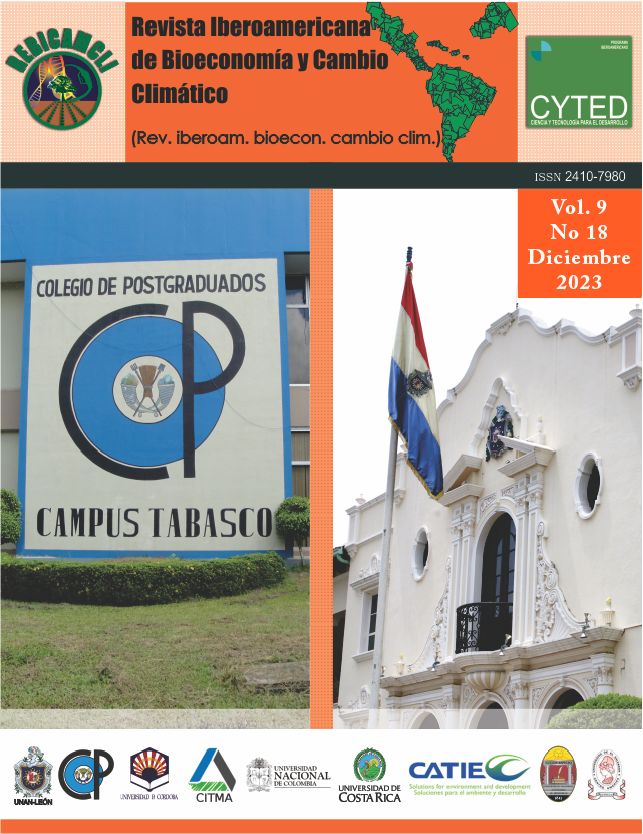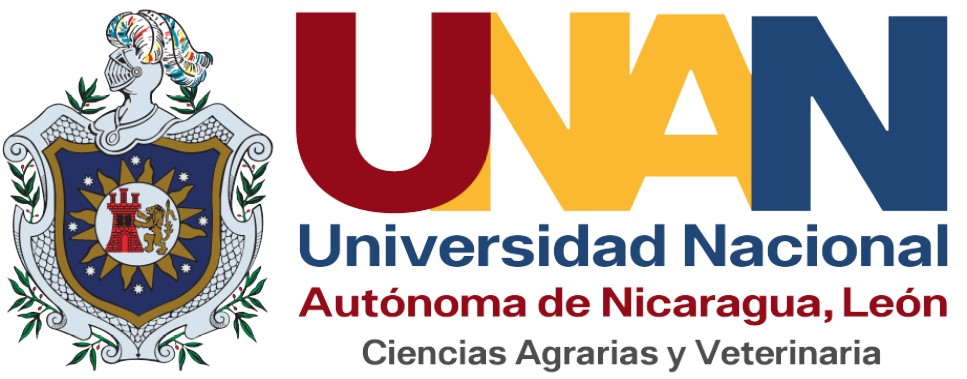Reactivation of two strains of the nuclear polyhedrosis virus VPNHz1991 for the management of the corn earworm (Helicoverpa zea)
DOI:
https://doi.org/10.5377/ribcc.v9i18.17547Keywords:
baculoviridae, entomopathogen, biopesticide, biotechnology, noctuidaeAbstract
Background: Currently producers use insecticides against pests, a viable alternative is the use of Nuclear Polyhedrosis Virus. Objective of the work was to reactivate the VPNHz1991 strain, for the management of Helicoverpa zea, six treatments and six repetitions were used. Methodology: The treatments were: Viral concentration of 93 LE with three larval instars and viral concentration of 96 LE with three larval instars. A bioassay was carried out with L1, L2 and L3 instar larvae, with 25 larvae per treatment, inoculating the treatments into the artificial diet so that it is ingested by the larvae. A mortality of 100% was obtained for instars L1 and L2 and 97% for instar L3. The lethal time obtained was 192 h, complying with what was expected from the action of the virus. To determine the PIB polyhedral inclusion body count, the Neubauer chamber was used on a microscope where two batches harvested from the concentrations used were used. Results: The counting result for the harvested lot (116 LE) of the 93 LE concentration was 9.2X109 and for the harvested lot (119) of the 96 LE concentration was 1.34X1010, being very good results. Conclusions: The reactivation of the VPNHz1991 strain was achieved, presenting excellent biological activity in Helicoverpa zea larvae despite the years of inactivity, demonstrating that the VPNHz1991 viral strain used in the study is suitable for use as a biological control agent for management. of the corn worm.Downloads
Metrics
References
Afolami, O. y M. Oladunmoye. (2017). Baculoviruses: Emerging Frontiers for Viral Biocontrol of Insect Pests of Agricultural Importance. Journal of Advances in Microbiology, 5(4), 1-7. https://doi.org/10.9734/JAMB/2017/35927.
Alves, S. (1986). Controle Microbiano de Insectos. Editora LTDA. -Sao Paulo (Brasil).
Arana Ríos, A. E. y Cárdenas Corrales, H. F. (2003). Estudio del comportamiento de la especie Spodoptera sunia lepidoptera: noctuidae utilizando dos dietas artificiales diferentes para su producción masiva. Campus Agropecuario 2003. (Monografía de grado Universidad Nacional Autónoma de Nicaragua, León). Repositorio institucional, UNAN-León. http://riul.unanleon.edu.ni:8080/jspui/bitstream/123456789/1250/1/192009.pdf
Lecuona, R. (1996). Microorganismos Patógenos empleados en el control Microbiano de Insectos Plaga. Editorial Leucona, Castelar.
Brunetti, M., Magoga, G., Gionechetti, F., De Biase, A. & Montagna, M. (2022). Does diet breadth affect the complexity of the phytophagous insect microbiota? The case study of Chrysomelidae. Environmental Microbiology, 24(8), 3565-3579
Capinera, J. (2001). Handbook of vegetable pests. Academic Press, San Diego 729p.
Castillo, P., Acosta, N. & Ciliézar, A. (1995). Control microbiológico de plagas artrópodas. Manual para la enseñanza del control biológico en América Latina. Escuela Agrícola Panamericana El Zamorano, Tegucigalpa (Honduras).
Castro, J. (2019). Presencia y patogenicidad del Virus de la Poliedrosis nuclear en larvas de lepidópteros del cultivo de Quinua en la Región Puno. (Monografía de grado, Universidad Nacional del altiplano de Puno).
Cave, R. D., Trabanino, R. & Pitty, A. (2011). Zamorano y sus contribuciones a la agricultura sostenible a través del control biológico de plagas. Ceiba, 52(1), 26-38.
Chen, T., Hu, N., Tan, L., Xiao, Q., Dong, Z., Chen, P., Zu, A., Pan, M. y Lu, C. (2018). Resistant silkworm strain block viral infection independent of melanization. Pesticide Biochemistry and Physiology. 154, 88-96 https://doi:10.1016/j.pestbp.2018.12.012
Coronado, I., Castillo, M. & Delgado. G. (2012). Efecto del virus de la poliedrosis nuclear y de neem (Azadirachta indica) en el consumo de hojas de maíz (Zea mays) y la mortalidad en larvas de diferentes instar de Spodoptera frugiperda, en condiciones de laboratorio. Campus Agropecuario UNAN-León 2011 (Tesis de grado, Universidad Nacional Autónoma de Nicaragua, León). Repositorio Institucional, UNAN-León.
Cory, J. S. & Myers, J. H. (2003). The ecology and evolution of insect baculoviruses. Annual Review of Ecology, Evolution, and Systematics, 34(1), 239-272. https://doi.org/10.1146/annurev.ecolsys.34.011802.132402
Cruz Valdez, E. A. (2002). Estimación de la DL50 y DL90 del virus Poliedrosis nuclear autographa californica en Spodoptera exigua y Helicoverpa zea. (Tesis de grado, Zamorano, Honduras).
El-Sheikh, E. (2015). Toxicidad comparativa y efectos subletales del benzoato de emamectina, lufenurón y spinosad en Spodoptera littoralis Boisd. (Lepidópteros: Noctuidae)). Protección de cultivos, 67, 228-234. http://dx.doi.org/10.1016/j.cropro.2014.10.022.
Espinoza, A., Cherry, A. & Cave, R. D. (1994). Efecto del VPN Galleria mellonella (L.) sobre larvas de Plutella xylostella (L.). Cieba, 35(1), 57-61 https://revistas.zamorano.edu/index.php/CEIBA/article/view/418
Fuxa, J. R. (1987). Ecological Considerations for the Use of Entomopathogens in IPM. Annual Review of Entomology, 32(1), 225-251. https://doi.org/10.1146/annurev.en.32.010187.001301.
Gómez Valderrama, J. A., Guevara Agudelo, E. J., Barrera Cubillos, G. P., Cotes Prado, A. M. & Villamizar Rivero, L. F. (2010). Aislamiento, identificación y caracterización de nucleopoliedrovirus nativos de Spodoptera frugiperda en Colombia. Revista Facultad Nacional de Agronomía Medellín, 63(2), 5511-5520. https://revistas.unal.edu.co/index.php/refame/article/view/25041/25580.
Groner, A. (1986). Specificity and safety of baculoviruses. In R. R. Granados and B.A. Federici (Eds), The Biology of Baculoviruses (Vol.1, pp.177-202). CRC Press, Boca Raton, Florida.
Huerta, N. y Arróliga, R. (2020). Establecimiento de cría de la especie Helicoverpa zea, hospedero del Virus de la Poliedrosis nuclear VPN-Hz, bajo condiciones de laboratorio periodo de marzo-octubre del año 2020. (Monografía de grado Universidad Nacional Autónoma de Nicaragua León). Repositorio institucional, UNAN-León.
Jiménez, E. (2009). Métodos de control de plagas. Universidad Nacional Agraria. Managua, Nicaragua.
Jiménez, E. & Rodríguez, O. (2014). Insectos: Plagas de cultivos en Nicaragua. Universidad Nacional Agrarias. https://repositorio.una.edu.ni/id/eprint/2700
Lezama, L. (2011). Actividad biológica de una formulación en polvo del virus de la poliedrosis nuclear (VPN) almacenado a diferentes temperaturas y eficacia para el control de Spodoptera exigua en el cultivo de cebolla, en Sébaco-Matagalpa. (Tesis de maestría, Universidad Nacional Autónoma de Nicaragua, León). Repositorio institucional, UNAN-León.
Quiroz-Medina, C. R., Real-Baca, C. I., Silva-Illescas, P. F. & Moreno-Mayorga, L. F. (2023). Preferencia de oviposición de Orius insidiosus (Hemiptera: Anthocoridae) en plantas herbáceas. Agronomía Mesoamericana, 34(1), Artículo 50410. https://doi.org/10.15517/am.v34i1.50410
Real-Baca, C. I. & Zuniga-Gonzalez, C. A. (2023). Periodical crossing of the laboratory population with the natural population would improve fitness in S. sunia. Lepidoptera: Noctuidae) [version 2; peer review: 1 approved with reservations]. F1000Research, 12:30 https://doi.org/10.12688/f1000research.129183.2
Reisig, D. (7 de enero de 2022). Helicoverpa Zea (gusano de la cápsula). CABI. https://doi.org/10.1079/cabicompendium.26776.
Rizo, C. y Narváez, C. (2001). Uso y producción de Virus de la Poliedrosis Nuclear en Nicaragua. Manejo integrado de plagas (Costa Rica), 61, 90-96
Romero Gutiérrez, M. I. & Cruz Reyes, C. M. (2011). Calidad de la cría de Spodoptera: algunos parámetros biológicos para su reproducción. Campus Agropecuario de la UNAN-León. Centro de Investigación y Reproducción de Controladores Biológicos (CIRCB) 2011. (Tesis de grado, Universidad Nacional Autónoma de Nicaragua, León). Repositorio institucional, UNAN-León.
Sánchez, J., Valle, J., Pérez, E., Neira, M. y Calderón Arias, C. (2019). Control biológico de Spodoptera frugiperda en cultivo de Zea mays: Uso de nematodos entomopatógenos. Scientia Agropecuaria, 10(4), 551-557.
Sosa Gómez, D. R., Morgado, F. S., Correa, F. S. T., Silva, L. A., Ardisson, M. P., Rodrigues, B. M. P., Oliveria, E. E., Aguiar, R.W. S. y Riveiro, B. M. (2020), Entomopathogenic Viruses in the Neotropics: Current Status and Recently Discovered Species. Entomología neotropical, 49, 315,39. https://doi.org/10.1007/s13744-020-00770-1.
Urbina, F. y Valle, C. (2012). Evaluación de la calidad de la producción del virus de la poliedrosis nuclear de Spodoptera sunia (SsVPN) del Laboratorio del Centro de Investigación y Reproducción de Controladores Biológicos (CIRCB), en el Campus Agropecuario. UNAN-León, 2012. (Monografía de grado, Universidad Nacional Autónoma de Nicaragua, León). Repositorio institucional, UNAN-León.
Vargas, L. (2009). Interacción de un baculovirus con azadiractina para el control del gusano cogollero, Spodoptera frugiperda (J.E. Smith) (Lepidoptera: noctuidae). (Tesis de grado, Instituto Tecnológico de Costa Rica). Repositorio Institucional Tecnológico de Costa Rica https://repositoriotec.tec.ac.cr/bitstream/handle/2238/2911/Informe_Final.pdf?sequence=1&isAllowed=y
Villamizar, L. F., Cuartas, P., correal, C. E. & Lopez-Ferber, M. (2018). Virus entomopatógenos en el control biológico de insectos. En Control biológico de fitopatógenos, insectos y ácaros: agentes de control biológico(pp. 372-401). Agrosavia.
Yu, S. J. (1983). Age Variation in Insecticide Susceptibility and Detoxification Capacity of Fall Armyworm (Lepidoptera: Noctuidae) larva1. Journal of Economic Entomology, 76(2), 219–222. http://dx.doi.org/10.1093/jee/76.2.219
Downloads
Published
How to Cite
License
Copyright (c) 2023 Rev. iberoam. bioecon. cambio clim.

This work is licensed under a Creative Commons Attribution-NonCommercial-ShareAlike 4.0 International License.
Copyright © 2025 Rev. iberoam. bioecon. climate change. National Autonomous University of Nicaragua León (UNAN-León), Knowledge Area of Agrarian and Veterinary Sciences / Specific Area of Agroecology and Agribusiness / Center for Research in Agrarian Sciencies. Academic Directorate. Research Department. Publication and scientific events Unit.












 EDITORIAL
EDITORIAL e-ISSN
e-ISSN


 COPYRIGHT
COPYRIGHT This work is licensed under a Licencia Internacional
This work is licensed under a Licencia Internacional 












